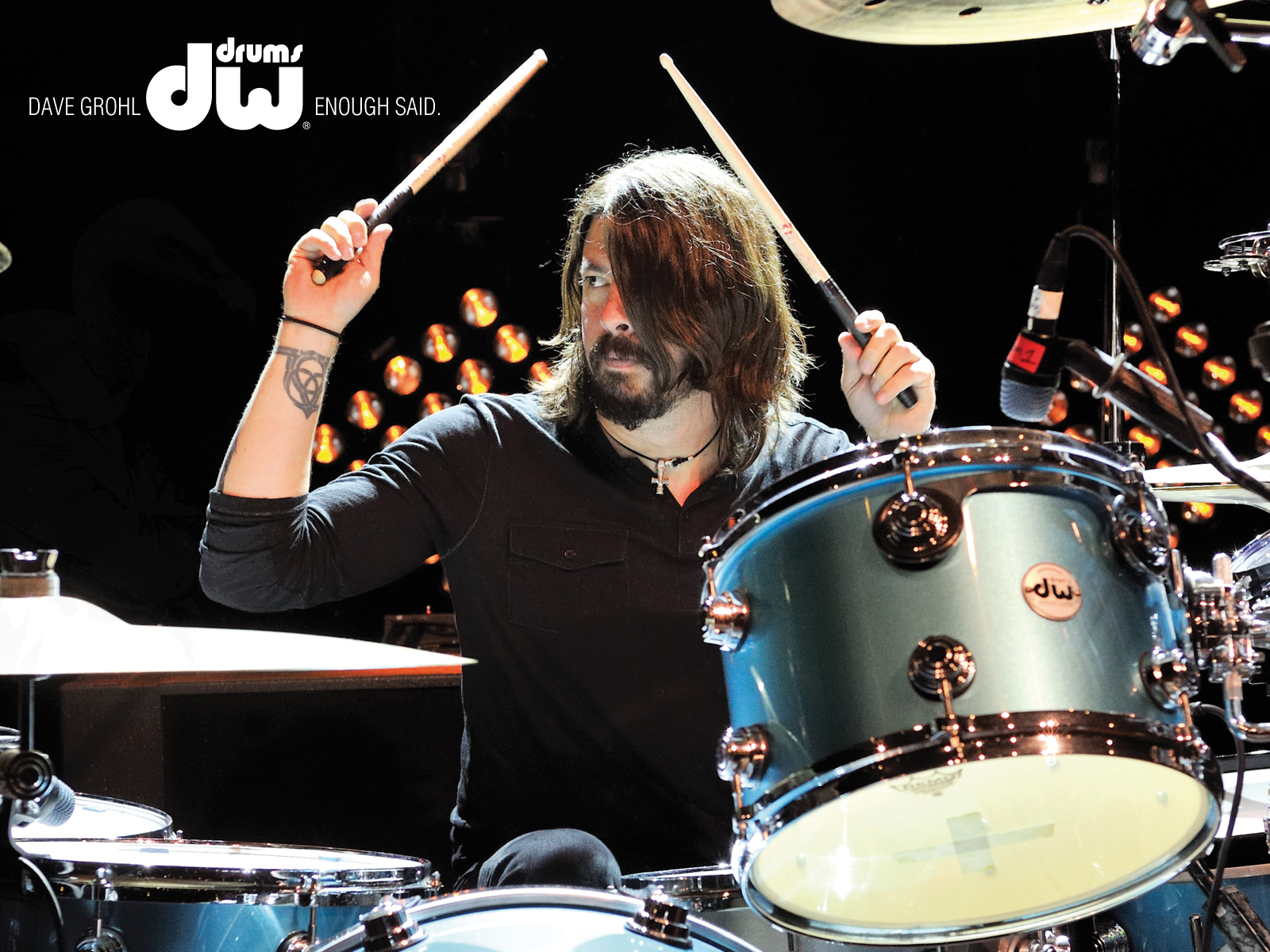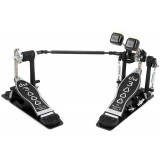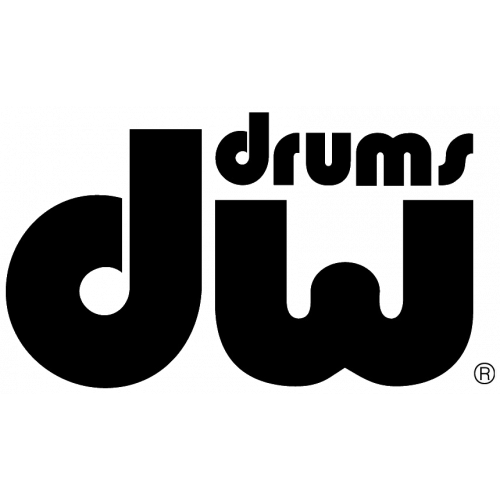 At Drum Workshop, The Drummer's Choice® is more than a slogan, it's a fact. After more than thirty years of innovation and tireless dedication to improving the way drum products are made, DW drums, pedals and hardware are the standard by which all others are measured. To get here, it takes more than a working knowledge of the instrument or a few good ideas; it takes a true passion for designing and manufacturing the very best. "It's remarkable that in our 31st year, the excitement level of coming to work is every bit as much now as when we started," DW Founder and President Don Lombardi says.
At Drum Workshop, The Drummer's Choice® is more than a slogan, it's a fact. After more than thirty years of innovation and tireless dedication to improving the way drum products are made, DW drums, pedals and hardware are the standard by which all others are measured. To get here, it takes more than a working knowledge of the instrument or a few good ideas; it takes a true passion for designing and manufacturing the very best. "It's remarkable that in our 31st year, the excitement level of coming to work is every bit as much now as when we started," DW Founder and President Don Lombardi says.
It all began in 1972 when Don, at age 26, opened a small teaching studio in Santa Monica, Calif. He called the studio Drum Workshop, offering both private lessons and monthly workshops. "My fascination with drums started at 12 with a neighborhood teacher at a local music store," Don recalls. "Over the years, I had such great experiences with renowned teachers that as my love for playing drums grew, so did my love for learning and teaching about drums. The day I got my driver's license, I started driving to teach at a local music store where I had taken lessons."
Seeing an ad for Drum Workshop in the Yellow Pages, John Good, now DW's Vice President, signed up for lessons at age 17 to improve his drumming and reverse what he refers to as "bad drumming habits."
"After three months of lessons, Don approached me and said, 'You know, I've had lots of successful students. I don't think you're going to be one of them'," John says laughing. "So I said, 'Great…now what are we going to do?'"
Realizing that overhead was eating up his profits, Don brought in investors and additional teachers and began selling sticks, books and drums to help subsidize the expenses. Hiring John as a part-time sales manager, the two spent hours discussing different ways to improve the art of drumming through improving drum products.
"That's how the spark and enthusiasm got started," John recalls. "We would talk for hours about our ideas for creating better products. Before we knew it, we were working together."
Out of these brainstorms came the first DW product: Don's new design for a height-adjustable trap-case seat. Selling about a dozen seats a month, John quit his day job and went to work full-time for Don.
"After teaching all day, we would move the drum sets to the side and bring out the tables to make the seats," Don remembers. "Then I'd usually leave for my playing job, and John would stay into the night to build the seats and fill the orders. I even bought a sewing machine to sew on the top of the seats, but John put his foot down and said, 'No sewing: I don't sew.'" "...we had learned that if we could offer drummers products that would improve their drumming, we could be successful."
When DW received a purchase order for 100 seats from Camco Drum Co., Don and John realized that they had an innovative product that would sell. Thirty years later, DW is now offering a new version of the trap-case adjustable seat, made out of a lighter weight material, called the 6100 Adjustable Trap-Case Seat.
"I always dreamed about creating a lighter weight seat, but we didn't have the money to do it back then," Don says. "I'm as confident about this new seat as I was when we made our first design." However, when DW created the original trap case seat, they had the capacity and personnel to create only a dozen seats a month, not 100. Don was still teaching and playing a nightly gig while John built the products. Shortly thereafter, Camco Drum Co. owner Tom Beckman approached Don in 1977 with an offer to sell him Camco's machinery, dies and molds, everything it took to make Camco drums and hardware—everything except the Camco name itself. This gave Don the opportunity to expand his capacity for creating the seats and to expand his product line. At that point, Don made the decision to accept the offer and change the direction of Drum Workshop from teaching and selling to manufacturing.
"The idea of failing never really occurred to me," Don remarks. "Based on our mini-success with the seat, we had learned that if we could offer drummers products that would improve their drumming, we could be successful. Of course, having a desire to go into manufacturing and having the money to do so are two different things."
Borrowing most of the money from his parents and some from outside investors, Don purchased Camco's tooling and reintroduced the Camco 5000 nylon strap bass drum pedal under the DW name. The pedal was refined to improve consistency, quietness, smoothness and adjustability of its mechanical operation. As the pedal was rapidly becoming "the drummer's choice," Don continued to search for ways to further improve it.
The addition of the Chain & Sprocket drive system in 1980 not only vastly improved the DW pedal, but also helped set it apart from others on the market. Three years later, DW introduced a double bass drum pedal that incorporated a unique linkage with universal joints. DW's 5002 Double Pedal not only filled a need and solidified DW's position in the market as innovators, it ushered in a whole new era in drumming since, for the first time, single bass drum players could now use both feet to create new rhythms and increase speed. Throughout the '80s, DW created other innovative DW hardware, such as the rotating two-leg 5500T and the remote (cable) 5502LB hi-hat stands, to meet the needs of DW Pedal endorsers like Travis Barker, Abe Laboriel Jr., Vinnie Colaiuta, Gary Novak and Carter Beauford. As Don was developing DW Pedals and Hardware, John was on the road building his expertise as a drum technician.
"Even though I wasn't a professional player, I always had an ear for drums and a knack for fixing them," he says. "I wound up on the road with bands like Earth, Wind and Fire and Frank Zappa. As I was out there tuning drums, I would find out what did and didn't work. I then came back and used that knowledge I was gaining to improve our products."
"I found out that everything about a drum's shell construction, shell size, bearing edges, heads, hardware and finishing individually and collectively affects the quality of a drum's sound." As a drum technician, John also discovered that each drum has a unique range where it sounds its best, eventually leading him to create DW's unique Timbre Matching system.
"I found out that everything about a drum's shell construction, shell size, bearing edges, heads, hardware and finishing individually and collectively affects the quality of a drum's sound," John says. "Don and I began making a few sets a month, always concentrating on perfecting each one of these acoustically critical elements.
"As I learned about each drum's timbre, or tonal range where the drum sounds its best, I became extremely interested in trying to control the timbre of the shell and, in doing so, improving the balance of the entire kit," John continues. "We later called this process 'Timbre Matching' and I'm proud to say that DW's 'Timbre Matching' caused a wholesale change in the way drummers think about their drums. I'm also extremely proud that every set we make today is made with the same care and attention to detail as when we were only making a few sets each month."
By the '80s, with endorsements by the world's top drummers, an expanding dealer network and a strong marketing campaign, DW's full line of top-quality bass drum pedals and hi-hat stands had created a unique market position for the small American company. Meanwhile, DW Drums were starting to attract attention throughout the drumming world, as well. To accommodate the increased demand for its hardware products, DW doubled its manufacturing space, moving to Newbury Park, Calif.
"I remember being on the road with Jonathan Moffett and Madonna in 1987 and calling the shop to check in," John recalls. "Don said, 'You need to come home. If we're going to make this thing happen, it needs to be right now.' When you hear that in someone's voice, you basically pack up and follow your heart."
"One of the things that helped convince me that we might have a chance with the drums was when Tommy Lee (Motley Crue) came into the shop to have his pedals tuned up," Don adds. "While he was waiting, he sat down at the set of drums John had in his office. He started playing and wouldn't stop; he was amazed at how the drums sounded. A light then went on in my head that Tommy Lee represented a generation of drummers who hadn't experienced handcrafted drums.

"A short time later, Tommy bought a kit from us. That was March 7, 1989. I remember the date because it was such a big event that I made a photocopy of the check, which I still have to this day. He was endorsing another company at the time, but within a year, he became an official DW Drum endorser."
With Tommy joining Jim Keltner, Chad Wackerman, Larrie Londin and other high-profile players, DW produced their first serious drum catalog and went to the January 1990 National Association of Music Merchants (NAMM) show, hoping to interest a handful of their top pedal dealers to each take one drum kit.
"At the end of the first day of the show, my son and sales manager, Chris, pulled John and me aside and told us that we had a real problem," Don says. "Chris had taken orders for 60 sets and it was only the first day of the show. We spent the rest of the year trying to catch up on orders before the next NAMM show. Fortunately, most of our customers have hung in there with us."

Since its first debut at NAMM, DW has pioneered the Delta Tri-Bearing pedal system featuring the patented Delta ball-bearing hinge, the Edge brass/maple snare drum, the concept of smaller F.A.S.T.® tom-tom sizes, the Woofer Bass Drum Tone Enhancer and the True-Pitch® Tuning System. In addition, DW has perfected a wide variety of Lacquer, Satin Oil and FinishPly™ drum finish choices. Today, drummer's drummers such as Sheila E., Terry Bozzio, Neil Peart, Marco Minnemann and Gary Novak, along with drummers of popular acts such as Madonna, Bruce Springsteen and the E Street Band, Dixie Chicks, Incubus, Mana, Missy Elliott, Avril Lavigne and so many more have chosen to play DW Drums, Pedals and Hardware exclusively.
To accommodate an increasing need for space, DW moved to its current facility in Oxnard, Calif., in 2000. That same year, DW created a new line of drums called Pacific Drums and Percussion to meet the demand for entry to mid-level players. The new line still uses some custom techniques, but primarily uses computerized machinery to cut costs and reduce steps to create high-quality drums in large quantities. DW moved most production of Pacific drums to a DW-run factory in Ensenada, Mexico, in 2002. Pacific Drums have now made DW's innovation and quality available to a larger market, while still maintaining the reputation of DW drums as high-end unique instruments. "While Pacific kits are high-quality, they're not high-priced because they're not custom," Don says. "With Pacific, you're not so much selling high-end features, as much as you're selling the opportunity for a person to get into playing drums no matter what their ability level."
In addition to expanding its product line, DW continues to create new drum concepts. John now carries the nickname as DW's "woodologist," continually searching out different wood to create unique sets. In the late '90s, John learned of 500-year-old hardwood that had sunk in Lake Superior 100 years ago. The logs were harvested by underwater treasure hunters and used to create DW's Timeless Timber line, featuring 25th Anniversary Lake Superior Maple sets in 1997 and DW's 30th anniversary Lake Superior Birch sets in 2002 (pictured at left). DW has also continued this tradition by releasing rare woods as limited edition Private Reserve kits. "What a find!" John exclaims. "It was practically an accident that these logs were even found, much less turned into musical treasures. Both the birch and the maple have a rare musical temperament due to the cold water curing the wood, but each also has its own unique tone. These drums are like no other in the world. What a way to celebrate 30 years in the business."
Along with expanded product lines, DW's 30th anniversary year included the addition of a new position, promoting Chris Lombardi, to Chief Executive Officer after 16 years of work with the company. "Like every small business, over the past 30 years, we all had to wear different hats," Don comments. "With Chris taking care of the company's day-to-day functions, John and I can continue to focus on creating new products that improve drumming."
DW's 30th anniversary also marked the release of the most technologically advanced pedal on the market. A limited number of precisely machined Titanium 9000 single and double pedals were released as testament to the custom features and patented technology that has continued to make DW pedals an industry standard. The numbered collector's pedals featured a titanium footboard, lightweight aluminium cam, patented Delta hinge and a certificate of authenticity. Later that year, the road- worthy production version of the 9000 series pedal was released and featured patented Floating Rotor Technology. This feature optimizes speed, power and precision with friction-reducing ball bearings in the rotor, mounted on a free-floating drive shaft, and incorporates several of the unique features that makes the 5000 Series line up of pedals standard issue for the world's top players. Over the years, one thing has remained constant, a ceaseless enthusiasm and the desire to keep making things better so that drummers can continue to raise the bar.

 ARTURIA Instruments
ARTURIA Instruments
 Drums for Therapy
Drums for Therapy  Harps
Harps
 Lyres
Lyres
 Didgeridoo
Didgeridoo
 Sound Processing
Sound Processing
 Mixing Consoles
Mixing Consoles
 Vinyl Players
Vinyl Players
 Phono Correctors
Phono Correctors
 Karaoke
Karaoke
 Stands and Holders
Stands and Holders
 Trolleys
Trolleys
 Computers, Electronics
Computers, Electronics




